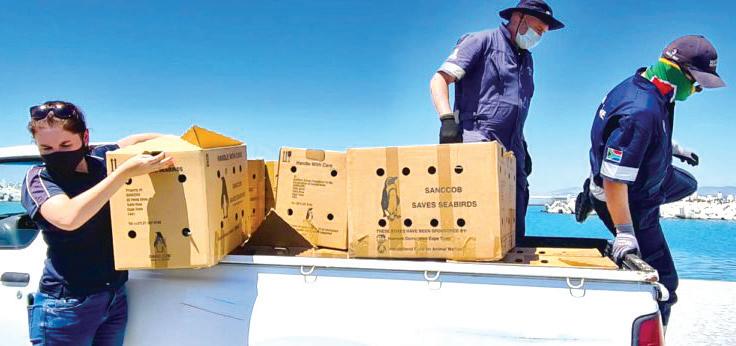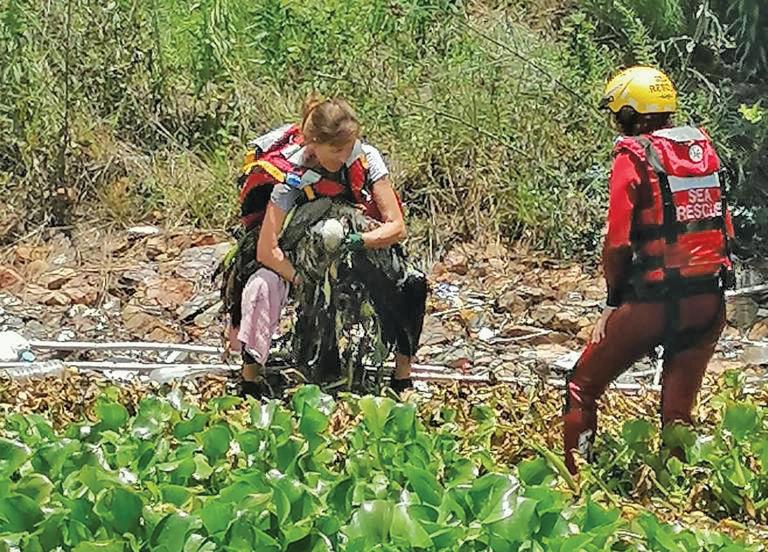
3 minute read
CREATURES GREAT AND (VERY SMALL)
During December 2020 and January and February this year, NSRI volunteers responded to assist a number of animals in distress. By Wendy Maritz
ABANDONED BABIES
On Tuesday 12 January, Station 3 (Table Bay) volunteers were asked by SANCCOB (Southern African Foundation for the Conservation of Coastal Birds) to help in an ongoing rescue operation involving the evacuation of a large number of Cape cormorant chicks that appeared to have been abandoned by the adults in the colony on Robben Island.
SANCCOB rangers on the island were monitoring the situation and grew concerned for the babies’ wellbeing when the parents failed to return. They had also started becoming easy prey for kelp gulls and ibises. A decision was made to intervene, and additional SANCCOB rangers, along with staff from the Two Oceans Aquarium and the Robben Island Museum, began gathering the chicks into boxes to be brought to SANCCOB for care and protection.
When the request for assistance came in, Station 3 launched Spirit of Vodacom, with a SANCCOB ranger on board, and on arrival at the island were guided to its northern side to begin collecting the chicks. A total of 128 chicks, loaded into 16 boxes, were brought to Murray’s Bay Harbour, loaded onto Spirit of Vodacom and taken to the base. From there the birds were taken to SANCCOB for further care.
The reasons for the abandonment are not clear, but it’s believed that declining stocks of small fish in the area have affected breeding cycles in the Cape cormorant as well as other marine bird colonies. Sadly, Cape cormorants are considered endangered because there has been a steep decline in numbers over the last three generations. SANCCOB’s Cape Town centre in Table View is caring for 1 170 Cape cormorant chicks, and staff are hoping to get them as healthy as possible before returning them to the wild. This avian rescue operation was the largest one undertaken in the Western Cape since the oil spill of the MV Treasure in 2020.

ABOUT A DONKEY
A few days after Christmas last year, Station 22 (Vaal Dam) was alerted to a lone donkey stranded on a small island near Deneysville on the Vaal Dam. The crew launched their rescue craft Harvey’s Fibreglass to investigate. They figured out that the donkey must have wandered off when the water level was low a few weeks before and was unable to return to the mainland once the level rose.
Station commander Jake Manten called in the help of a vet from Villiers Veterinary Hospital, who was brought to the island and confirmed the donkey was stressed and malnourished.
‘We brought our crock and a specialised stretcher to the scene. The donkey was tranquilised and loaded very carefully onto the stretcher and then into the crock,’ says Jake. ‘We used a larger rescue vessel to tow the crock back to the mainland, where the donkey was reunited with its human family. They were delighted to have it back.’
The animal had been missing for four weeks and might have succumbed to exposure had it not been spotted and rescued.

JUVENILE VULTURE FREED
Hartbeespoort Dam, known for its resort towns and leisure activities, is plagued by an invasion of water hyacinth, an aquatic plant native to South America, that covers about 30% of the water’s surface.
On Christmas Eve, concerned bystanders noticed a vulture trapped in this dense foliage. After their attempts to free it failed, they called the NSRI to assist. Crew launched Rotary Endeavor to investigate.
Station commander Arthur Crewe explains the rescue craft had to negotiate its way through 900m of dense water hyacinth growth before reaching the bird, which they found entangled in fishing line and trapped among the plants.
‘We were able to cut the vulture free. While we were busy, the exhausted animal barely put up any resistance. It tried to fly away but was too tired. It landed in the water and drifted, unable to get airborne,’ says Arthur. ‘Three rescue swimmers entered the water and helped corral the bird to the shore.’ The local vulture protection and conservation organisation Vulpro was asked to step in and arrived to take the vulture, whom they confirmed was about four months old, into their care for rehabilitation.










